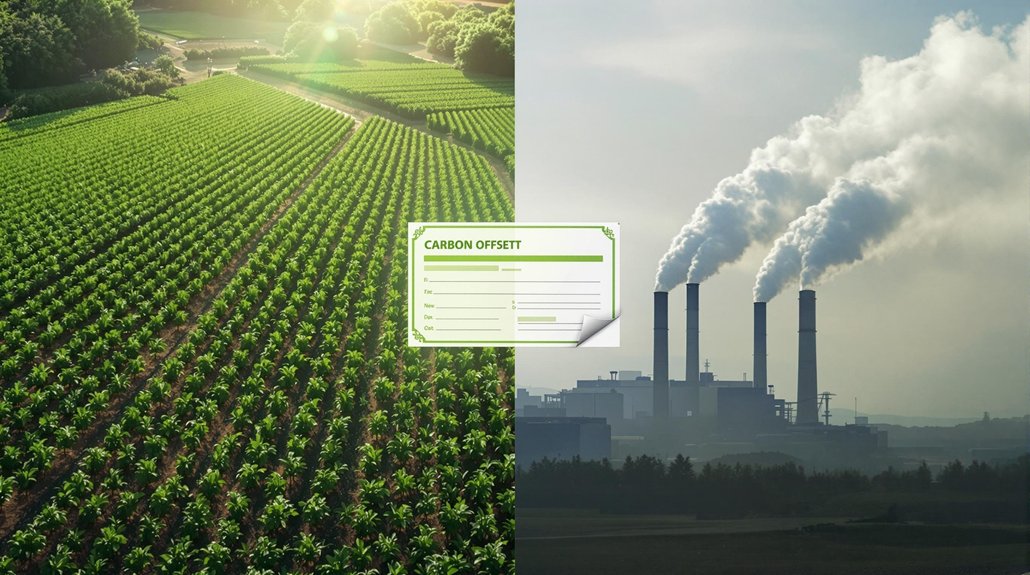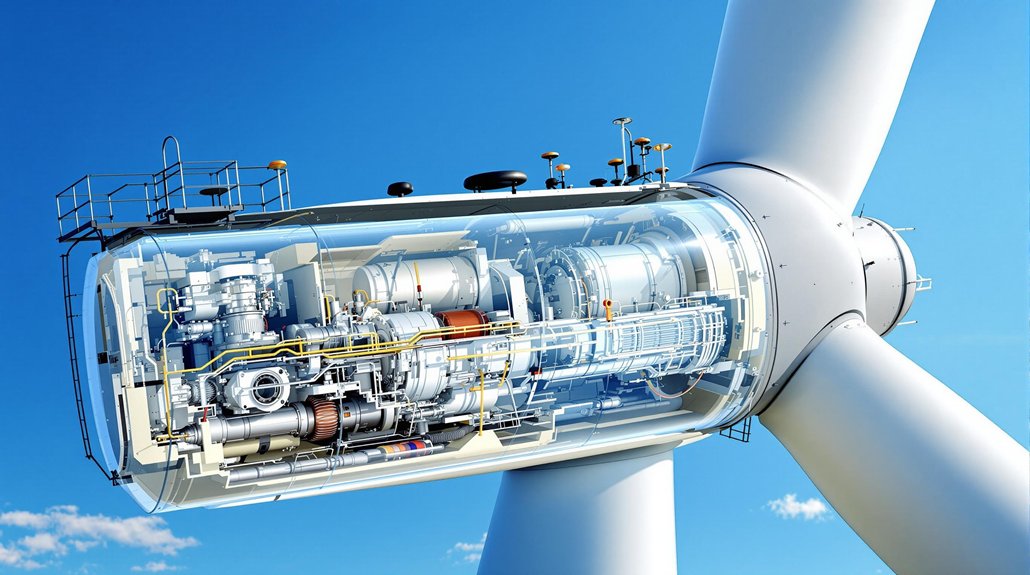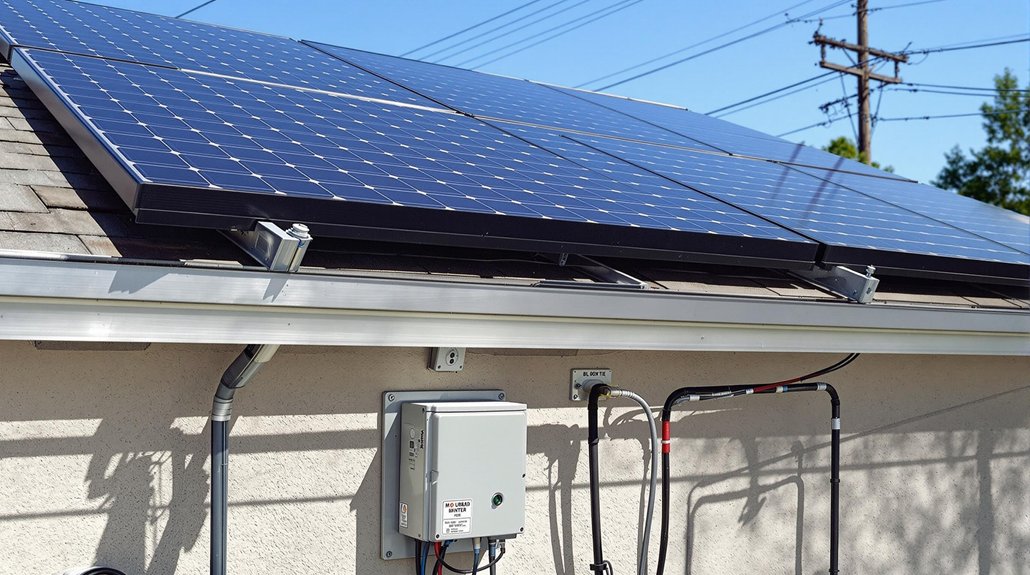Carbon offsets are tradable certificates that represent one ton of carbon dioxide removed from the atmosphere. They work by funding projects that reduce greenhouse gases, such as tree planting or renewable energy. When someone buys an offset, they’re balancing out their unavoidable emissions. Both individuals and companies use them in voluntary markets or for regulatory compliance. Prices range from $3 to $50 per ton. The certification process guarantees these climate solutions deliver real benefits.

The growing concern over climate change has put carbon offsets in the spotlight. Carbon offsets are tradable certificates that represent the reduction of one metric ton of carbon dioxide emissions. They allow individuals and businesses to balance their carbon footprint by investing in projects that reduce greenhouse gases elsewhere in the world.
These offsets work like a balancing act. When someone can’t avoid creating emissions, they can purchase offsets that fund projects reducing an equal amount of carbon somewhere else. These projects include planting trees, building wind farms, capturing methane from landfills, and improving energy efficiency in buildings.
Not all carbon offsets are created equal. Several certification standards exist to guarantee offsets deliver their promised benefits. The Verified Carbon Standard, Gold Standard, and Clean Development Mechanism are among the most respected certification programs. These standards require rigorous verification processes before carbon credits can be issued.
The verification process is thorough. Third-party auditors assess whether projects meet eligibility requirements and actually reduce emissions. They validate project designs, monitor results, and verify reductions against established baselines. Only after this process can carbon credits be issued and sold.
Carbon offsets are traded in two main markets. The voluntary market serves individuals and businesses that choose to offset their emissions. The compliance market serves companies that must reduce emissions under government regulations. Prices vary widely from $3 to over $50 per ton of CO2. Companies like Native Energy, 3Degrees, and Myclimate have emerged as leading offset providers that connect businesses with verified emission reduction projects.
While carbon offsets offer benefits like funding climate-friendly projects and supporting sustainable development, they face criticism too. Critics question whether offset projects truly create additional emission reductions that wouldn’t happen otherwise. Others worry about the permanence of reductions, especially in forest projects that could later be cut down. High-quality offset projects should demonstrate verifiable additionality to ensure they deliver real environmental benefits. Established in 1997, the Kyoto Protocol introduced international compliance carbon markets that created a framework for today’s offset trading systems.
Carbon offsets aren’t a perfect solution to climate change. They’re one tool among many that can help reduce global emissions while the world shifts to cleaner energy sources and more sustainable practices.
Frequently Asked Questions
How Much Do Carbon Offsets Typically Cost per Ton?
Carbon offset costs vary widely per ton of CO2.
In voluntary markets, prices typically range from $3-$5, while compliance markets run from $10-$100+.
The cost depends on project type:
- renewable energy ($5-$10)
- forestry ($10-$50)
- energy efficiency ($10-$25)
- direct air capture ($200-$600).
Experts predict prices will rise considerably, potentially reaching $20-$50 by 2030 and exceeding $100 by 2050.
Can Individuals Verify if Their Purchased Offsets Are Legitimate?
Individuals can verify their carbon offsets through several methods.
They can check for recognized certifications like Gold Standard or Verified Carbon Standard.
Public registries allow them to track their specific carbon credits using project ID numbers.
Transparent providers offer detailed project information and documentation.
Third-party auditors validate legitimate projects.
Many registries show when credits are properly “retired,” confirming they’ve been used to offset emissions.
Are Carbon Offsets Tax-Deductible?
Tax deductibility for carbon offsets varies considerably.
For individuals, offsets aren’t usually deductible unless they’re donations to qualified 501(c)(3) organizations.
Businesses may deduct offsets as ordinary and necessary expenses under Section 162.
International treatments differ by country. Australia, the UK, Canada, and South Africa each have their own rules.
Deductibility often depends on purpose, offset type, entity structure, accounting treatment, and proper documentation.
Which Industries Generate the Highest Quality Carbon Offset Projects?
Renewable energy projects tend to produce the highest quality carbon offsets.
Forestry initiatives, particularly avoided deforestation and reforestation, also rank highly when properly verified.
Industrial projects that destroy potent greenhouse gases like HFCs deliver substantial climate benefits.
Waste management offsets, especially landfill methane capture, can provide reliable emission reductions.
The quality largely depends on third-party verification and ensuring projects wouldn’t happen without offset funding.
How Long Does It Take for Offset Projects to Make Impact?
Carbon offset projects vary widely in their impact timelines.
Methane capture projects can show results in 6-12 months, while renewable energy takes 1-3 years to become operational.
Energy efficiency projects need 1-5 years depending on scale.
Reforestation requires 10-20 years for significant carbon sequestration.
Direct air capture provides immediate but initially small-scale impact.
Project size, regulatory approvals, funding, and technology readiness all affect how quickly results appear.









